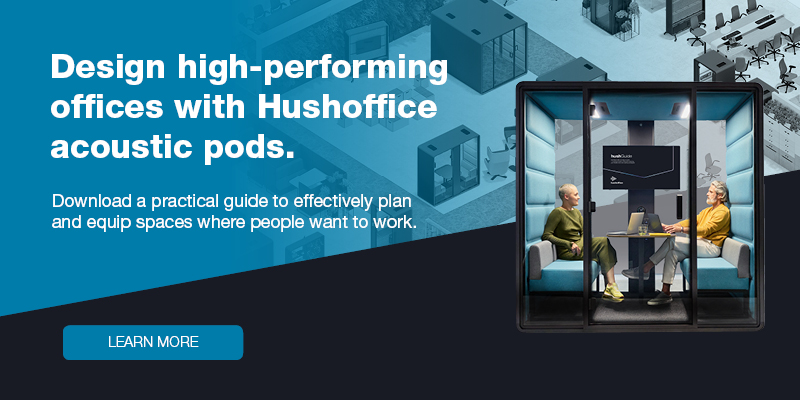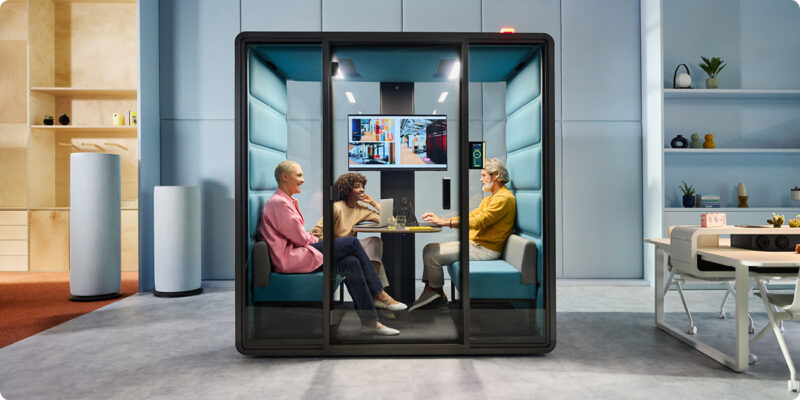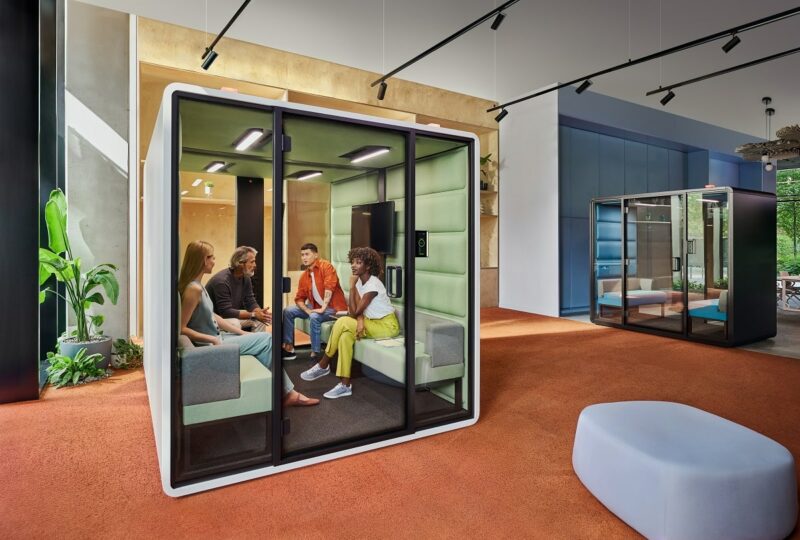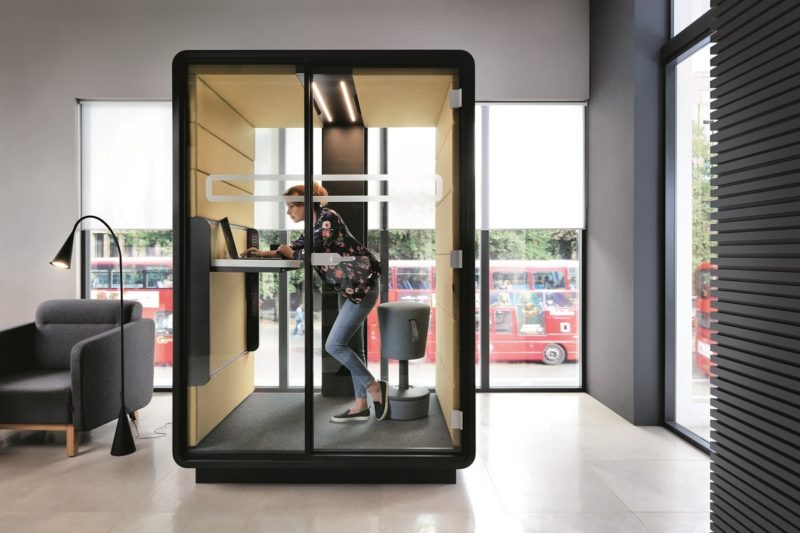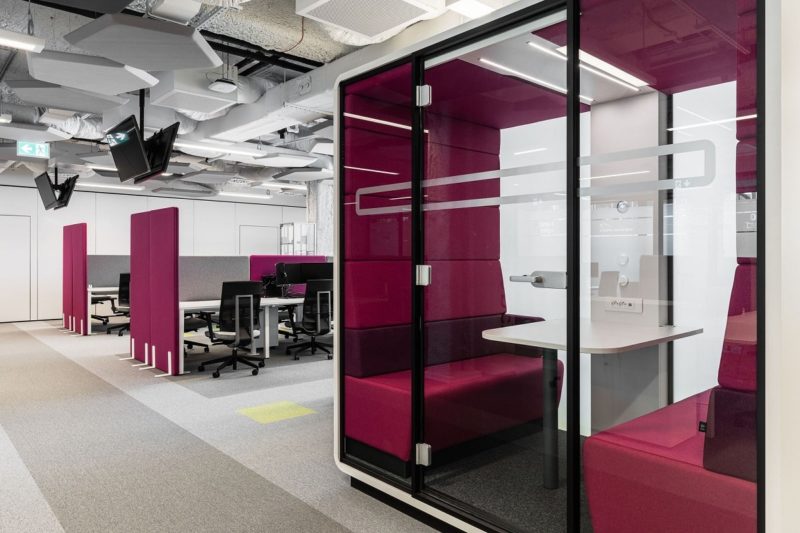Ways AI can transform the workplace
- Posted on: 4 June 2024
- By: Hushoffice Team
What does an AI-powered workplace look like? For architects, designers, employees, and facilities managers, AI’s influence will be perceived a little differently. Let’s dive in.
Using AI in the workplace – tl;dr
AI is remodelling office design for architects and designers in various ways, including automating routine tasks, providing deep data-driven insights, or offering comprehensive trend forecasting analytics. Additionally, its integration with VR and AR allows for interactive design visualisation.
When it comes to facility managers, the impact of AI is predominantly seen in data processing, enabling them to optimise space utilisation by monitoring occupancy and usage patterns. When used properly, AI can also be used to enhance energy management by evaluating and adapting to consumption patterns. Flexible furniture solutions, such as mobile office pods, will assist facilities managers in leveraging space optimisation tips continually provided by AI-powered assistants.
Employees’ primary touchpoint with AI will be videoconferencing. Firstly, the AI-powered technology will support users with real-time transcription, or even translation of the speech. Additionally, it will actually measure the level of participant involvement with the use of face recognition mechanisms. As video meetings are part and parcel of the hybrid work environment, video call booths such as hushFree.S will become an indispensable part of the office, enabling teams to fully leverage the potential of AI to foster human connection in the future.
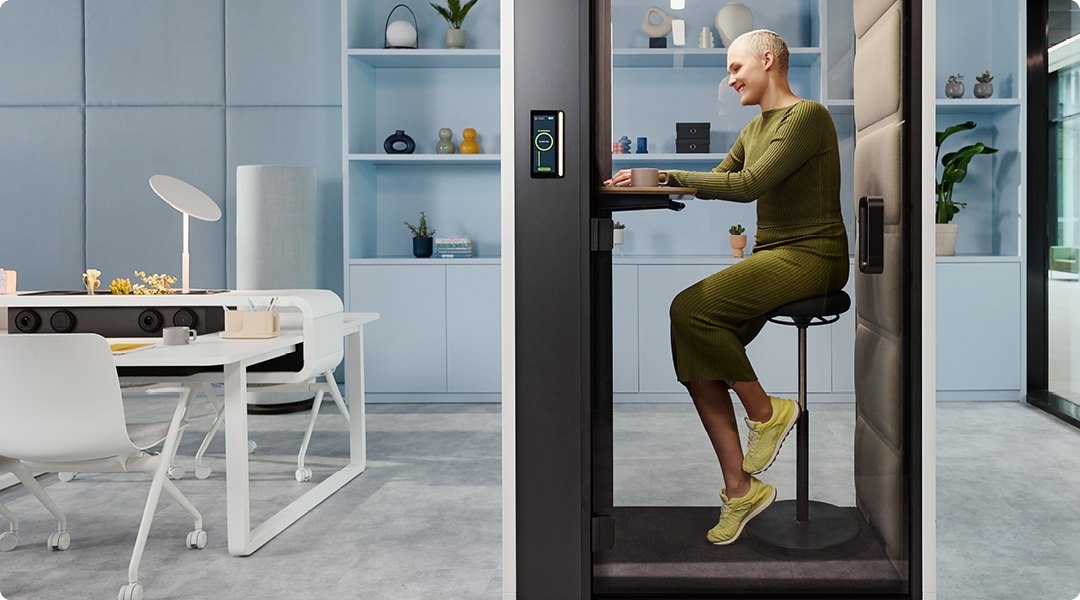
Surprisingly, artificial intelligence can unlock the most human-centric potential of office design so far. Traditionally, effective space planning aims to maximise efficiency while minimising costs, sometimes overlooking employee needs. Yet, with a strategic implementation of AI-based tools, designers may create workspaces adjusted to employees’ individual requirements and needs. AI’s superpower is its robust analytical capabilities, enabling it to process vast amounts of input data. When it comes to the designing process, this data is connected with how workers utilise office spaces, their preferences, work routines, and even physiological responses to various office settings. So, effective working environments are on the cards
– says Mateusz Barczyk, Senior Brand Manager, Hushoffice.
AI can enhance the space-planning process, ensuring optimisation, and improving efficiency.
The robust capabilities of AI to collect and integrate data enable professionals to get a deeper understanding of how spaces are utilised. Given the qualitative and quantitative data, designers can get a fuller perspective of the office space. And this insight is gold.
Data is everything, and AI can leverage it brilliantly.
In the future, businesses will leverage the increased data-analysis capacity of artificial intelligence to evaluate their space needs, modifying their furniture arrangement to fit the evolving work patterns. This means that offices will become more flexible and responsive to changing employee needs.

With AI, choosing the optimal layout and space plan is a breeze.
The perfect workspace for a hybrid team must foster relationship building. However, optimising any layout, whether large or small, can pose a real challenge as navigating the nuances and assessing various options against tight schedules and budgetary constraints is no mean feat. Here, AI can provide a spot-on solution.
Overwhelmed by excessive information? AI can make sense of it all.
For example, occupancy tracking systems collect a vast amount of data that may appear overwhelming. However, AI can analyse it in order to suggest the most responsive space programming systems, enabling optimal arrangement of space for employee performance and overall satisfaction.
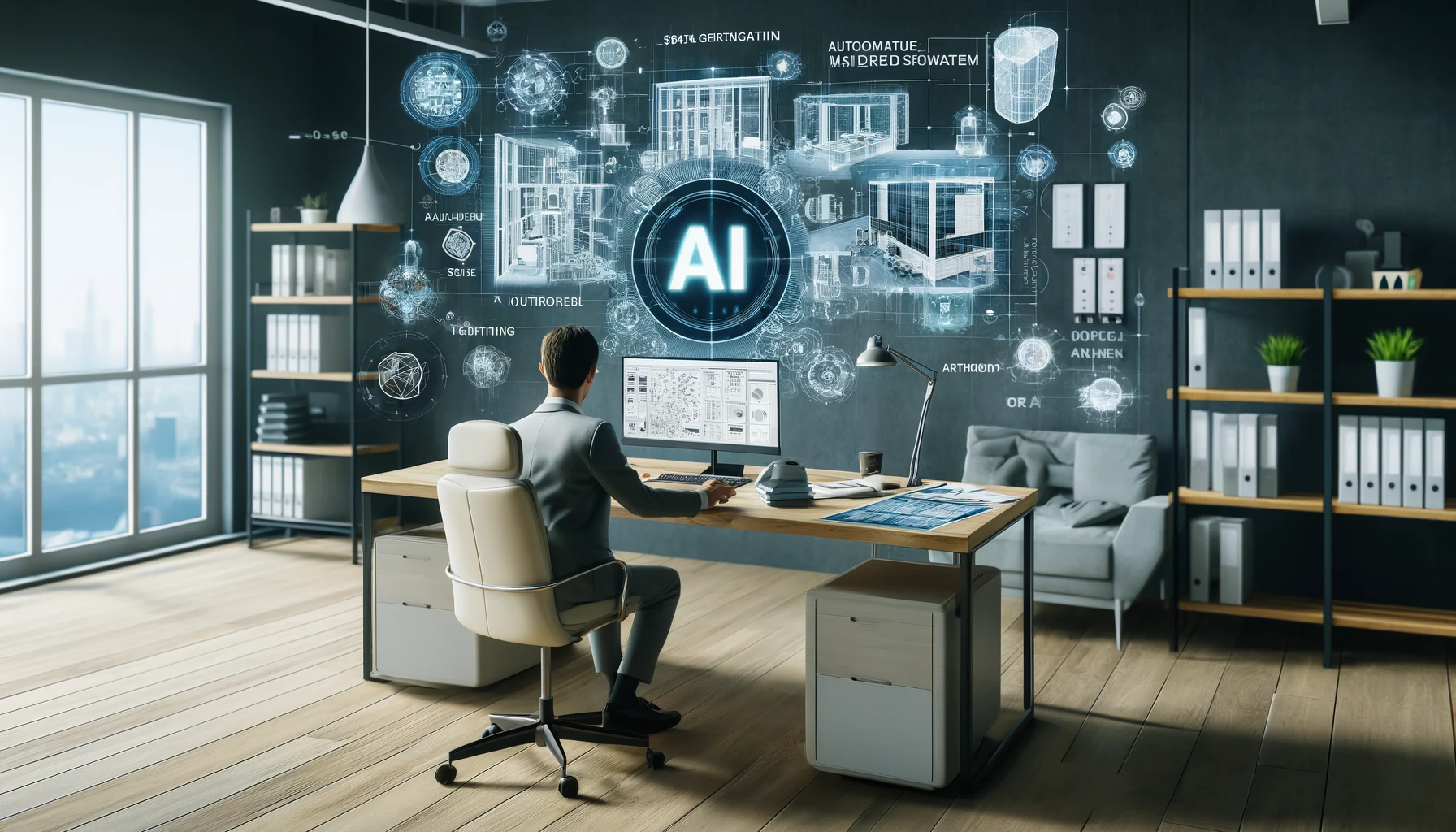
– says Mateusz Barczyk, Senior Brand Manager, Hushoffice.Artificial intelligence can analyse information, taking into account a vast array of factors. The qualitative and quantitative aspects of light flow within a space. Visibility between team members who closely cooperate. Distance to call spaces. Balancing these factors with one another poses a considerable challenge, given how difficult it is to gauge them. However, AI can resolve such intricate spatial issues instantly. And flexible furniture solutions, including portable cubicles and office booths, such as pods from the hushFree line (comprising hushFree.S, hushFree.M and hushFree.L) are part and parcel of the AI-automated workspace design puzzle. In fact, mobile, customisable pieces enable space designers to effortlessly try out a variety of setups by seamlessly changing furniture arrangements within the office layout. Simultaneously, AI bears the brunt of collecting and analysing data on how a particular setup works in practice over weeks and discerning the reasons for space underutilisation. Regardless of insights AI provides, flexible furniture can be immediately relocated whenever necessary, addressing identified weaknesses without delay
AI may improve office utilisation by offering predictive analysis.
The right data input enables AI to create workspace designs focused on essentials, whether it’s energy efficiency or employee focus. Thanks to its capabilities to analyse and understand how workers move around and interact within a space, AI effectively prioritises objectives such as collaboration and interaction, thereby helping achieve them.
Equipped with sensors, the workspace can transform into an ultimately adaptive environment.
With AI, the office can become highly adaptive, constantly adjusting to emerging needs by means of real-time data analysis and automation. Such potential will be based on sensors installed to gather and interpret information on occupancy levels, light flow, temperature, air quality, and more.
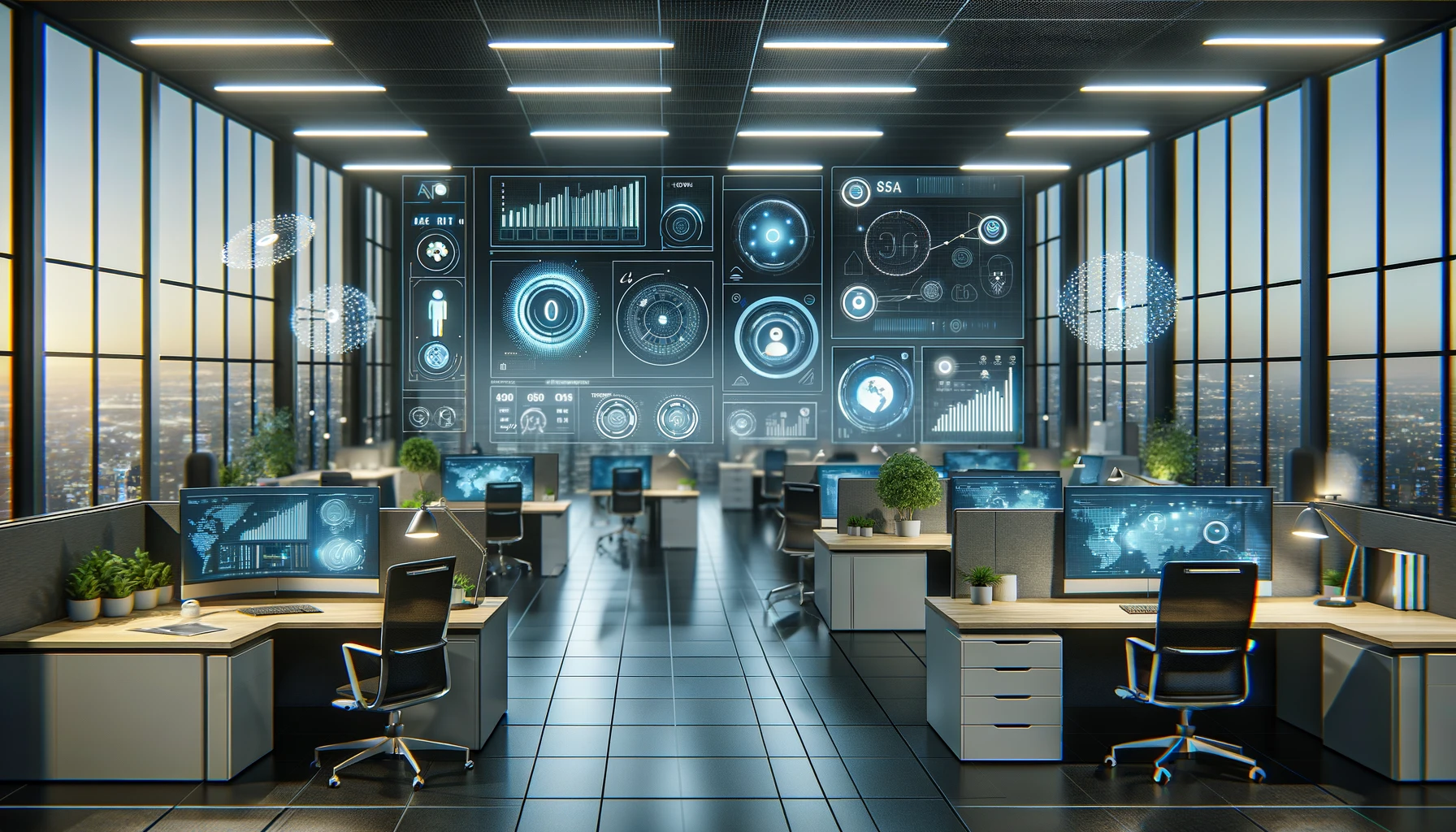
Will AI lead to the emergence of self-learning workplaces? Potentially yes.
Through analysing a vast amount of user-behaviour and space-utilisation data points, algorithms can discern patterns and trends. With minimal manual intervention, AI can come up with recommendations based on these patterns and trends, automatically offering design suggestions.
AI will take over tedious tasks, allowing architects and designers to focus on other aspects of their work.
In fact, AI can perform tasks that architects might spend days on, in just a few seconds. This does not only spare architects from a vast amount of tiresome work, but also allow for office adjustments to be provided to employees much more quickly.
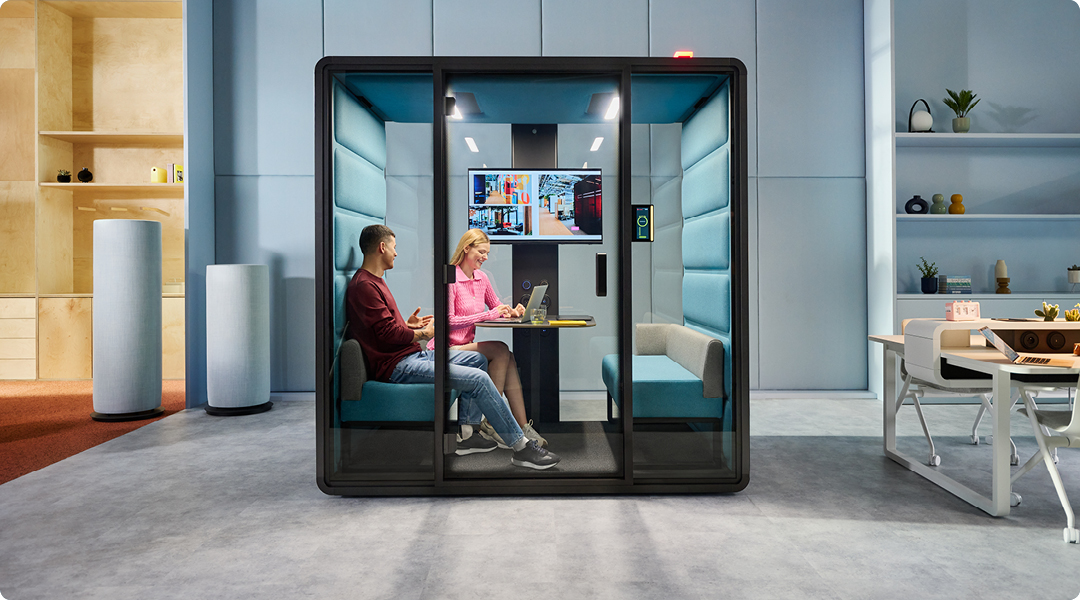
Properly used, AI will revolutionise the quality of videoconferencing.
AI-powered audio enhancers are already improving speech intelligibility by reducing background noise. Additionally, AI can enhance meeting accessibility by providing real-life speech transcription. AI is also used in apps to improve eye contact, thereby enhancing the meeting experience and ensuring participants are better heard and seen.
AI may enhance engagement during virtual meetings.
AI-powered face recognition technology will be used more and more to measure participants’ interest and engagement during video calls. By automatically recording and evaluating meetings, AI can provide businesses with detailed insights into what contributes to the efficiency of meetings, and what leads to their success or failure. With this technology, managers can also obtain valuable information, which will allow them to identify and support workers who require attention. In the future, office design will include modern videoconferencing areas equipped with sensors to gather data, leading to the increased popularity of professional video call booths such as hushFree.S, improving these essential touchpoints
– says Mateusz Barczyk, Senior Brand Manager, Hushoffice.
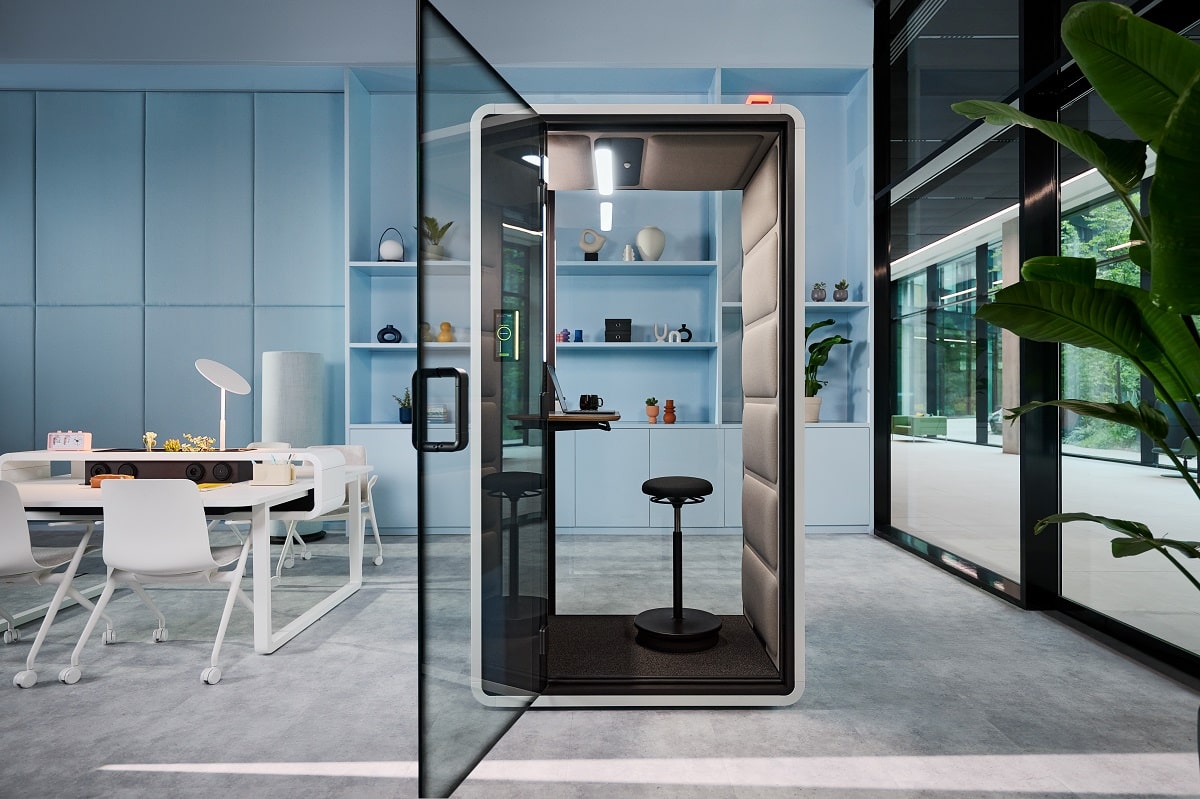
Facilities managers will gain deeper insights into building performance data.
With AI sensor networks, FMs will gain access to vast amounts of data, enabling them to move beyond simple maintenance and delve into strategic planning. In all cases, the ultimate aim will be responsiveness, strongly supported by AI’s detailed depiction of a building.
By leveraging mechanisms to gather data and insights, facilities managers will be able to collect valuable information on workspace utilisation and identify areas for improving employee efficiency. The advancement of AI and its ability to extract practical information from data will provide an opportunity to continuously optimise office environments for workers. As a result, workspaces will always reflect the most productive layout and atmosphere of the moment. Naturally, when offices successfully address employee expectations, occupancy rates might rise, reshaping the hybrid-work landscape entirely
– says Mateusz Barczyk, Senior Brand Manager, Hushoffice.
Using AI in the workplace – tl;dr
AI is remodelling office design for architects and designers in various ways, including automating routine tasks, providing deep data-driven insights, or offering comprehensive trend forecasting analytics. Additionally, its integration with VR and AR allows for interactive design visualisation.
When it comes to facility managers, the impact of AI is predominantly seen in data processing, enabling them to optimise space utilisation by monitoring occupancy and usage patterns. When used properly, AI can also be used to enhance energy management by evaluating and adapting to consumption patterns. Flexible furniture solutions, such as mobile office pods, will assist facilities managers in leveraging space optimisation tips continually provided by AI-powered assistants.
Employees’ primary touchpoint with AI will be videoconferencing. Firstly, the AI-powered technology will support users with real-time transcription, or even translation of the speech. Additionally, it will actually measure the level of participant involvement with the use of face recognition mechanisms. As video meetings are part and parcel of the hybrid work environment, video call booths such as hushFree.S will become an indispensable part of the office, enabling teams to fully leverage the potential of AI to foster human connection in the future.
AI in the workplace – frequently asked questions
How will AI transform the future office?
Thanks to AI, the workplace will become more responsive to employee needs. Offices will increasingly implement strategic sensor networks that combined with AI-powered tools can process data from these networks, providing robust insights into how workspaces are utilised.
Can I use AI to design my office?
Yes! However, while AI algorithms can simplify and enhance the process of designing a workspace, they cannot generate ideas. Experts predict that in the future architects and designers will leverage AI to balance variables, including light flow or distance to call spaces. Yet, human creativity will stay crucial.
How can AI improve meetings?
AI can ensure better eye contact, provide real-time transcription, utilise facial recognition and emotion analysis to measure engagement, and enhance both audio and visual quality during video calls.

